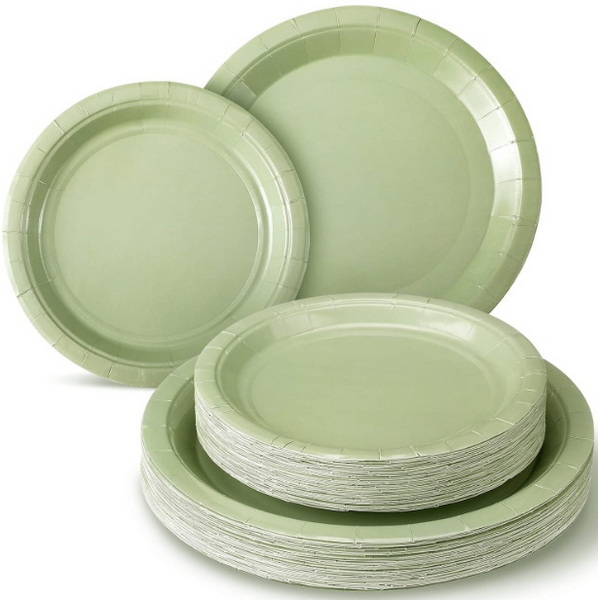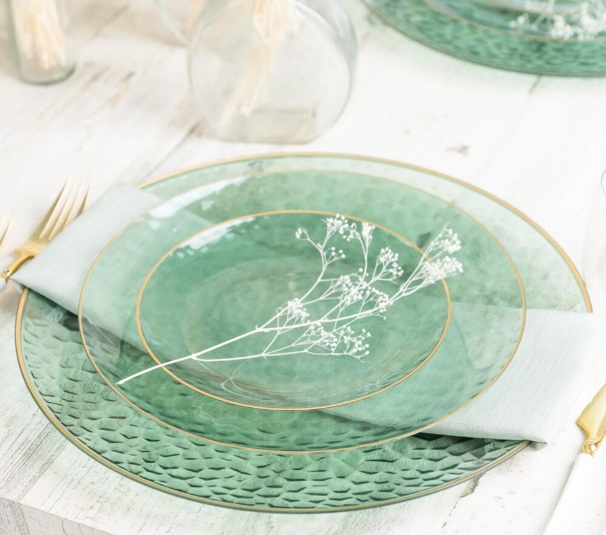
Content Menu
● Introduction to Green Disposable Tableware
>> Benefits of Green Disposable Tableware
● Materials Used in Green Disposable Tableware
● Enhancing the Event Experience with Green Disposable Tableware
>> Supporting Health and Safety
● Meeting Regulatory Requirements
>> Cost Considerations
● Future Trends in Green Disposable Tableware
>> Edible Tableware
>> 3D Printing and Circular Economy Practices
● Market Growth and Consumer Demand
>> Ethical Sourcing and Carbon Footprint Reduction
● Conclusion
● FAQs
>> 1. What Materials Are Used to Make Green Disposable Tableware?
>> 2. How Does Green Disposable Tableware Support Eco-Friendly Waste Management?
>> 3. Is Green Disposable Tableware More Expensive Than Traditional Options?
>> 4. Can Green Disposable Tableware Be Reused?
>> 5. How Does Green Disposable Tableware Enhance the Event Experience?
● Citations:
In recent years, the importance of sustainability has become increasingly evident, especially in the context of events and gatherings. One of the most effective ways to reduce environmental impact during events is by using green disposable tableware. This eco-friendly alternative not only helps minimize waste but also enhances the overall experience for attendees by showcasing a commitment to environmental responsibility.

Introduction to Green Disposable Tableware
Green disposable tableware is made from biodegradable materials such as sugarcane bagasse, cornstarch, bamboo, palm leaves, and wheat straw. These materials are renewable, non-toxic, and can decompose naturally, reducing the amount of plastic waste that ends up in landfills and oceans.
Benefits of Green Disposable Tableware
1. Reduces Environmental Impact: Unlike traditional plastic tableware, which takes hundreds of years to decompose, green disposable tableware breaks down naturally within a few months, minimizing landfill contributions and greenhouse gas emissions.
2. Promotes Eco-Friendly Waste Management: It supports composting systems, converting waste into nutrient-rich compost that can enrich soil, thus promoting eco-friendly waste management.
3. Minimizes Plastic Pollution: By replacing single-use plastics, it significantly reduces the ecological footprint of your event.
4. Aligns with Sustainability Goals: Opting for green disposable tableware demonstrates a commitment to eco-conscious practices, resonating with environmentally aware attendees.
5. Simplifies Waste Disposal: Compostable materials streamline clean-up by reducing waste sorting challenges.
Materials Used in Green Disposable Tableware
- Sugarcane Bagasse: A durable and heat-resistant material often used for plates, bowls, and trays. It is a byproduct of the sugar extraction process, making it a sustainable choice by utilizing agricultural waste[5].
- Cornstarch: Processed into polylactic acid (PLA), commonly used for cutlery and cups. PLA is biodegradable and compostable, offering a greener alternative to traditional plastics[1].
- Bamboo Fiber: Naturally strong and flexible, used for plates and utensils. Bamboo is highly renewable, as it grows rapidly and can be harvested in as little as three years[2].
- Palm Leaves: Dried areca palm leaves pressed into shapes for plates and bowls. This material is fully compostable and does not require cutting down trees, as it uses fallen leaves[2].
- Wheat Straw: A lightweight byproduct of wheat farming, used for plates and containers. It is biodegradable and compostable, reducing reliance on non-renewable resources[7].
Enhancing the Event Experience with Green Disposable Tableware
Choosing green disposable tableware for your event not only benefits the environment but also enhances the overall experience for your guests. It sends a strong message about your commitment to sustainability, which can positively impact your event's reputation and appeal to environmentally conscious attendees.
Supporting Health and Safety
Traditional plastic tableware often contains harmful chemicals like BPA and phthalates, which can leach into food and beverages, posing health risks. In contrast, green disposable tableware is free from these toxic substances, ensuring a safer experience for both people and the environment.

Meeting Regulatory Requirements
With the growing awareness of environmental issues, many regions are implementing stricter regulations on single-use plastics. By choosing green disposable tableware, you can ensure compliance with these regulations and avoid potential fines or negative publicity.
Cost Considerations
While green disposable tableware may have a higher upfront cost compared to traditional plastic options, it offers significant long-term benefits. The cost of eco-friendly tableware is decreasing as more companies produce sustainable products, making it an increasingly affordable and smart investment for businesses.
Future Trends in Green Disposable Tableware
The future of disposable tableware is evolving rapidly, with innovations in biodegradable materials, edible tableware, and 3D printing technologies. These advancements promise to further reduce environmental impact while maintaining convenience and aesthetic appeal[3].
Edible Tableware
Edible tableware, made from ingredients like rice, wheat, and potatoes, is gaining momentum as a sustainable solution. It not only eliminates waste but also offers a unique dining experience, allowing consumers to eat their utensils after a meal[3].
3D Printing and Circular Economy Practices
3D printing allows for customization and precision in designing eco-friendly tableware, reducing material waste and energy consumption. Additionally, adopting circular economy practices involves collecting, recycling, and repurposing used tableware, minimizing waste and conserving resources[3].
Market Growth and Consumer Demand
The global market for biodegradable disposable tableware is expected to grow significantly, driven by environmental sustainability trends and stringent regulations limiting plastic use[6]. Consumers are increasingly willing to pay a premium for eco-friendly products, driving businesses to adapt and offer sustainable solutions[8].
Ethical Sourcing and Carbon Footprint Reduction
Companies are focusing on ethical sourcing and sustainable harvesting practices to minimize their environmental impact. This includes sourcing materials from responsibly managed farms and implementing carbon-neutral initiatives in manufacturing and shipping processes[4].
Conclusion
Incorporating green disposable tableware into your events is a crucial step towards sustainability. Not only does it reduce environmental impact, but it also enhances the event experience and supports health and safety. As the demand for eco-friendly products continues to grow, choosing green disposable tableware is a responsible and forward-thinking decision for any event organizer.

FAQs
1. What Materials Are Used to Make Green Disposable Tableware?
Green disposable tableware is made from renewable materials such as sugarcane bagasse, cornstarch, bamboo, palm leaves, and wheat straw. These materials are biodegradable and compostable, reducing environmental impact.
2. How Does Green Disposable Tableware Support Eco-Friendly Waste Management?
Green disposable tableware supports composting systems by converting waste into nutrient-rich compost that can enrich soil, thus promoting eco-friendly waste management.
3. Is Green Disposable Tableware More Expensive Than Traditional Options?
Yes, green disposable tableware is generally more expensive upfront than traditional plastic options. However, it offers long-term benefits by reducing environmental cleanup costs and enhancing a business's sustainability image.
4. Can Green Disposable Tableware Be Reused?
Most green disposable tableware is designed for single use, but some items like palm leaf plates can be washed gently and reused a few times for dry food.
5. How Does Green Disposable Tableware Enhance the Event Experience?
Choosing green disposable tableware sends a strong message about your commitment to sustainability, enhancing your event's reputation and appealing to environmentally conscious attendees.
Citations:
[1] https://packthismeal.com/blogs/article/a-guide-to-eco-friendly-disposable-tableware
[2] https://www.restaurantware.com/blogs/eco-friendly-solutions/guide-to-eco-friendly-tableware
[3] https://www.ep-products.com/news/the-evolution-of-environmentally-friendly-disp-71445714.html
[4] https://jollychef.com/blogs/news/the-future-of-disposable-tableware-sustainability-innovation-design-trends-for-2025
[5] https://www.linkedin.com/pulse/growing-demand-eco-friendly-tableware-packaging-food-industry
[6] https://foodhq.world/issue-sections/catering-hospitality/disposables/global-biodegradable-disposable-tableware-market-2023-to-2030-driven-by-environmental-sustainability-trends/
[7] https://www.webstaurantstore.com/guide/655/green-disposable-dinnerware-guide.html
[8] https://www.linkedin.com/pulse/rising-demand-eco-friendly-disposable-tableware-360iresearch-mfrwf
[9] https://www.linkedin.com/pulse/booming-biodegradable-tableware-industry-its-trends-eco-clicky
[10] https://www.mdpi.com/2071-1050/17/4/1434
[11] https://www.globenewswire.com/news-release/2024/10/29/2970595/28124/en/Biodegradable-Disposable-Tableware-Market-Research-2024-2030-with-Analyst-Recommendations-Expand-Product-Range-and-Customization-Options-Promote-Circular-Economy-Practices.html
[12] https://www.cnfoodcontainer.com/news/Disposable%20Tableware%20Materials%20Innovation:%20The%20Future%20of%20the%20Food%20Service%20Industry/
[13] https://www.iccn.hku.hk/cover-story-of-science-reducing-single-use-cutlery-with-green-nudges-evidence-from-chinas-food-delivery-industry/
[14] https://www.accessnewswire.com/newsroom/en/industrial-and-manufacturing/disposable-plates-market-to-expand-at-36-cagr-through-2035-driven-by-fo-983798
[15] https://cosmosecofriends.com/the-future-of-biodegradable-plates-innovations-and-trends/
[16] https://www.scmp.com/comment/hk-opinion/article/3256442/hong-kong-plastic-ban-lets-aim-reusables-not-green-disposables
[17] https://greentableware.hk/en-us/home/about
[18] https://www.econaike.com/news/trends-in-the-environmentally-friendly-tableware-industry-the-green-revolution-is-sweeping-the-world-and-the-future-is-here/
[19] https://www.thesociableweavers.com/adapting-disposable-tableware/
[20] https://ecoclicky.com/en/biodegradable-tableware-market/

















